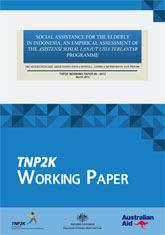Social Assistance for the Elderly in Indonesia: An Empirical Assessment of the Asistensi Sosial Lanjut Usia Terlantar Programme
Working Paper 05 - 2013
Authors: Sri Moertiningsih Adioetomo, Fiona Howell, Andrea McPherson, Jan Priebe1
ABSTRACT
Indonesia has undergone a demographic transition since the 1970s that has led to significant changes in the population age structure of the country. Life expectancy at birth increased from 45 years to 67 years. The number of elderly people aged 60 and above rose from about 5 million in 1970 to 18 million in 2010, and is projected to increase to over 71 million in 2050. The economic situation for many elderly persons is precarious. In 2011, 12 percent of older people were below the official poverty line. Older people, especially those in their 70s and those aged 80 and above, have the highest poverty rates among the population groups, 13.3 percent and 16 percent respectively. At the same time, a much greater proportion of the elderly population than officially classified as poor is vulnerable to falling into poverty. Moreover, many of the elderly suffer from poor health and have low literacy levels.
Currently, the coverage of the elderly with the existing formal pension schemes is very low. The Government of Indonesia (GOI) recognizes the gaps in the social insurance schemes and is explicitly taking actions to improve pension coverage. ASLUT, the current social assistance programme targeted directly at poor and neglected elderly, started in 2006 in six provinces reaching 2,500 beneficiaries. It has recently expanded to all 33 provinces and increased the number of recipients to 13,250 in 2011, and 26,500 beneficiaries in 2012. This paper explores the strengths and weaknesses of the coverage provided to the elderly and recommends that the ASLUT programme be developed further to meet the demographic challenges that Indonesia faces.
To request copies of the report or for more information on the report, please contact the TNP2K Knowledge Management Unit (kmu@tnp2k.go.id)
